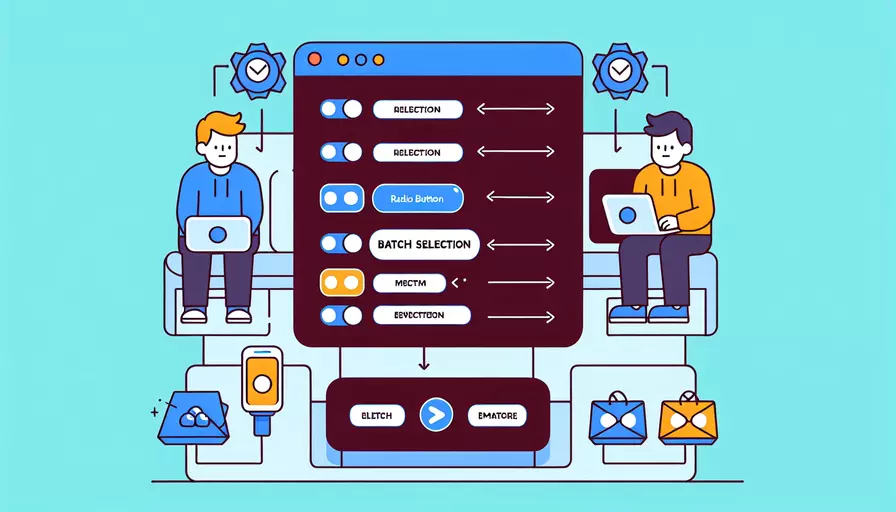
在Vue中,要实现radios的批量选择,可以通过以下几步来完成:1、定义一个数组来存储选中的值,2、在模板中使用v-for来遍历生成radio按钮,3、使用v-model绑定radio按钮的值。以下是详细的实现步骤:
一、定义数据结构
首先,我们需要定义一个数组来存储选中的值,以及一个数组来存储所有的选项。
new Vue({
el: '#app',
data: {
selectedValues: [], // 存储选中的值
options: [
{ id: 1, label: 'Option 1' },
{ id: 2, label: 'Option 2' },
{ id: 3, label: 'Option 3' },
{ id: 4, label: 'Option 4' }
]
}
});
二、生成radio按钮
在模板中使用v-for指令遍历options数组,并生成相应的radio按钮。使用v-model指令将每个radio按钮绑定到selectedValues数组。
<div id="app">
<div v-for="(option, index) in options" :key="index">
<input type="checkbox" :value="option.id" v-model="selectedValues">
<label>{{ option.label }}</label>
</div>
<p>Selected Values: {{ selectedValues }}</p>
</div>
三、处理批量选择
为了实现批量选择功能,我们可以添加两个按钮:一个用于全选,另一个用于取消全选。我们需要在methods中定义相应的处理函数。
<div id="app">
<div v-for="(option, index) in options" :key="index">
<input type="checkbox" :value="option.id" v-model="selectedValues">
<label>{{ option.label }}</label>
</div>
<p>Selected Values: {{ selectedValues }}</p>
<button @click="selectAll">Select All</button>
<button @click="deselectAll">Deselect All</button>
</div>
new Vue({
el: '#app',
data: {
selectedValues: [], // 存储选中的值
options: [
{ id: 1, label: 'Option 1' },
{ id: 2, label: 'Option 2' },
{ id: 3, label: 'Option 3' },
{ id: 4, label: 'Option 4' }
]
},
methods: {
selectAll() {
// 将所有选项的id添加到selectedValues数组中
this.selectedValues = this.options.map(option => option.id);
},
deselectAll() {
// 清空selectedValues数组
this.selectedValues = [];
}
}
});
四、解释和背景信息
- 数据绑定:通过Vue的
v-model指令,可以方便地实现数据的双向绑定。当用户选择或取消选择某个radio按钮时,selectedValues数组会自动更新。 - 动态生成:使用
v-for指令可以轻松地遍历数组并生成多个DOM元素。在这个例子中,我们遍历options数组生成了一组radio按钮。 - 批量操作:通过定义
selectAll和deselectAll方法,可以实现批量选择和取消选择。selectAll方法将options数组中所有选项的id添加到selectedValues数组中,而deselectAll方法则清空selectedValues数组。
五、实例说明
假设我们有一个表单,需要用户选择多个选项。在实现批量选择功能后,用户可以通过点击“Select All”按钮,一次性选中所有选项。点击“Deselect All”按钮,则可以取消所有选项的选择。这种功能在实际应用中非常常见,如批量操作邮件、批量删除文件等。
<div id="app">
<h1>Batch Selection Example</h1>
<div v-for="(option, index) in options" :key="index">
<input type="checkbox" :value="option.id" v-model="selectedValues">
<label>{{ option.label }}</label>
</div>
<p>Selected Values: {{ selectedValues }}</p>
<button @click="selectAll">Select All</button>
<button @click="deselectAll">Deselect All</button>
</div>
new Vue({
el: '#app',
data: {
selectedValues: [],
options: [
{ id: 1, label: 'Option 1' },
{ id: 2, label: 'Option 2' },
{ id: 3, label: 'Option 3' },
{ id: 4, label: 'Option 4' }
]
},
methods: {
selectAll() {
this.selectedValues = this.options.map(option => option.id);
},
deselectAll() {
this.selectedValues = [];
}
}
});
六、总结和建议
通过以上步骤,我们可以在Vue中实现radios的批量选择功能。总结来说,主要步骤包括定义数据结构、生成radio按钮、处理批量选择操作。
进一步的建议包括:
- 优化用户体验:可以添加一些提示信息或确认对话框,以防止用户误操作。
- 处理边缘情况:例如,当所有选项都被选中时,禁用“Select All”按钮;当没有选项被选中时,禁用“Deselect All”按钮。
- 可扩展性:如果选项数量较多,可以考虑使用分页或滚动加载的方式,提升性能和用户体验。
通过这些改进,可以使批量选择功能更加完善,满足不同场景的需求。
相关问答FAQs:
1. Vue中如何实现radios的批量选择?
在Vue中,我们可以使用v-model指令和v-for指令来实现radios的批量选择。下面是一个简单的示例:
<template>
<div>
<label v-for="option in options" :key="option.id">
<input type="radio" v-model="selectedOptions" :value="option.id">
{{ option.label }}
</label>
<button @click="selectAll">全选</button>
<button @click="clearAll">清空</button>
</div>
</template>
<script>
export default {
data() {
return {
options: [
{ id: 1, label: '选项1' },
{ id: 2, label: '选项2' },
{ id: 3, label: '选项3' }
],
selectedOptions: []
};
},
methods: {
selectAll() {
this.selectedOptions = this.options.map(option => option.id);
},
clearAll() {
this.selectedOptions = [];
}
}
};
</script>
在上面的示例中,我们首先定义了一个选项数组options,其中包含了三个选项。然后,我们使用v-for指令将每个选项渲染为一个radio input,并使用v-model指令将选中的选项与selectedOptions绑定起来。当用户选择一个选项时,selectedOptions数组会自动更新。
同时,我们还添加了两个按钮,分别用于全选和清空选项。点击全选按钮时,我们将selectedOptions数组设置为包含所有选项的id的数组,实现了批量选择的功能。点击清空按钮时,我们将selectedOptions数组设置为空数组,清空了所有选项的选择。
2. Vue中如何实现radios的批量选择并显示选中数量?
在Vue中,我们可以通过计算属性来实现radios的批量选择并显示选中数量。下面是一个示例:
<template>
<div>
<label v-for="option in options" :key="option.id">
<input type="radio" v-model="selectedOptions" :value="option.id">
{{ option.label }}
</label>
<p>选中数量:{{ selectedCount }}</p>
<button @click="selectAll">全选</button>
<button @click="clearAll">清空</button>
</div>
</template>
<script>
export default {
data() {
return {
options: [
{ id: 1, label: '选项1' },
{ id: 2, label: '选项2' },
{ id: 3, label: '选项3' }
],
selectedOptions: []
};
},
computed: {
selectedCount() {
return this.selectedOptions.length;
}
},
methods: {
selectAll() {
this.selectedOptions = this.options.map(option => option.id);
},
clearAll() {
this.selectedOptions = [];
}
}
};
</script>
在上面的示例中,我们添加了一个计算属性selectedCount来计算选中的选项数量。通过在模板中使用{{ selectedCount }}来显示选中数量。
3. Vue中如何实现radios的批量选择并限制最多选择数量?
在Vue中,我们可以通过添加逻辑来实现radios的批量选择并限制最多选择数量。下面是一个示例:
<template>
<div>
<label v-for="option in options" :key="option.id">
<input type="radio" v-model="selectedOptions" :value="option.id" :disabled="isDisabled(option.id)">
{{ option.label }}
</label>
<p>已选数量:{{ selectedOptions.length }}</p>
<button @click="selectAll">全选</button>
<button @click="clearAll">清空</button>
</div>
</template>
<script>
export default {
data() {
return {
options: [
{ id: 1, label: '选项1' },
{ id: 2, label: '选项2' },
{ id: 3, label: '选项3' }
],
selectedOptions: []
};
},
methods: {
isDisabled(optionId) {
return this.selectedOptions.length >= 2 && !this.selectedOptions.includes(optionId);
},
selectAll() {
this.selectedOptions = this.options.map(option => option.id);
},
clearAll() {
this.selectedOptions = [];
}
}
};
</script>
在上面的示例中,我们添加了一个isDisabled方法来判断某个选项是否应该被禁用。在这个示例中,我们限制最多选择2个选项,当已选数量达到2个时,未选中的选项将被禁用。
通过在v-for指令中使用:disabled="isDisabled(option.id)"来动态设置每个选项的禁用状态。同时,我们还在模板中显示已选数量。
文章标题:vue如何实现radios的批量选择,发布者:飞飞,转载请注明出处:https://worktile.com/kb/p/3675195

 微信扫一扫
微信扫一扫  支付宝扫一扫
支付宝扫一扫 